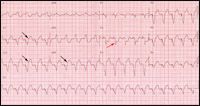STEMI With Underlying Paced Rhythm
According to the Sgarbossa criteria, the patient had an acute MI: ECG revealed a greater than 1-mm ST-segment depression in lead V2 and about 5-mm discordant ST-segment elevation in leads II, III, and aVF.

Figure – The ECG shows ST-segment depression in lead V
2
(red arrow) and ST-segment elevations in leads II, III, and aVF (black arrows).
A 71-year-old woman with hypertension, type 2 diabetes mellitus, and transient ischemic attacks presented to the emergency department with epigastric and chest pain. The pain was nonradiating, dull in character, 6/7 on a scale of 1 to 10 in intensity. The patient also had one episode of emesis. A few days earlier, she had undergone placement of a permanent dual-chamber, rate-responsive pacemaker and right coronary artery percutaneous transluminal coronary angioplasty.
Examination revealed a new grade 3/6 pansystolic murmur, most audible over the apex with radiation to the axilla. Other physical findings were normal.
The patient's ECG demonstrated a ventricular paced rhythm with native P waves intact. Marked ST-segment depression was noted in lead V2 with discordant 5-mm ST elevations in leads II, III, and aVF (Figure). Although the first set of cardiac enzyme levels was borderline elevated, subsequent enzyme levels were consistent with acute myocardial infarction (MI). The patient was outside the window for thrombolytic therapy.
DIAGNOSIS OF ACUTE MI
Although cardiac enzyme levels are usually assessed in patients with suspected acute coronary syndromes, they are neither highly specific nor sensitive early in the disease.1 Positive serum markers suggest the diagnosis, but negative values do not exclude injury to the myocardium.2 Therefore, the ECG is the standard for diagnosing acute MI, particularly ST-segment elevation MI (STEMI).
According to the American College of Cardiology and American Heart Association, ECG findings alone should prompt immediate consideration of reperfusion therapy. However, abnormal baseline rhythms, such as left bundle-branch block (LBBB) and ventricular paced rhythm (VPR), often obscure the diagnosis of infarction or ischemia based on ECG changes. LBBB is seen in about 7% of patients with acute MI, but only 13% to 32% of patients with LBBB and chest pain have an MI.3 More important, 50% of patients with LBBB and acute MI do not have chest pain. LBBB shares a morphological similarity to VPR. The Sgarbossa criteria (Table) were developed to diagnose STEMI in patients with abnormal baseline rhythms.
The ASSENT 2 and 3 trials demonstrated the accuracy of the Sgarbossa criteria.4 The ECGs of 267 patients with LBBB and suspected MI were read by ECG experts who were unaware of cardiac enzyme levels and clinical outcomes. The Sgarbossa criteria were highly specific for acute MI diagnosis; a more extensive MI (peak CK/CK-MB greater than 5 times the upper limit of normal) and higher mortality at 30 days and 1 year were associated with a higher Sgarbossa score. These trials also revealed that the third criterion (ST elevation of at least 5 mm discordant with QRS complex) had minimal diagnostic and prognostic use in patients with LBBB. However, other studies have shown that this criterion has a high specificity and statistical significance when diagnosing acute MI in those with VPR. This patient's ECG revealed a greater than 1-mm ST-segment depression in lead V2 and about 5-mm discordant ST-segment elevation in leads II, III, and aVF. Thus, according to the Sgarbossa criteria, the patient had an acute MI.
In the original article published in New England Journal of Medicine, the Sgarbossa criteria came with a score for acute MI and LBBB.3 In the subsequent article published in American Heart Journal, the Sgarbossa criteria did not have a score for VPR; however, the study was underpowered.5 In that study of 17 cases of acute MI with VPR, the criterion that performed worst in the LBBB score system-discordant ST elevation of 5 mm or more-performed the best in VPR.
The Sgarbossa criteria can aid physicians in earlier recognition of STEMI in patients with VPR or LBBB, and they allow for timely treatment. Multiple studies, including the CADILLAC trial, have shown better clinical outcomes with early (less than 2 hours after symptom onset) reperfusion.6 They also demonstrated that delayed treatment is associated with higher mortality in high-risk patients and in those who present more than 2 hours after symptom onset.
References:
REFERENCES:
1.
Scanlon PJ, Faxon DP, Audet AM, et al. ACC/AHA guidelines for coronary angiography: executive summary and recommendations. A report of the American College of Cardiology/American Heart Association Task Force on practice guidelines (Committee on Coronary Angiography) developed in collaboration with the Society for Cardiac Angiography and Interventions.
Circulation
. 1999;99:2345-2357.
2.
Newby LK, Roe MT, Chen AY, et al; CRUSADE Investigators. Frequency and clinical implications of discordant creatine kinase-MB and troponin measurements in acute coronary syndromes.
J Am Coll Cardiol
. 2006;47:312-318.
3.
Sgarbossa EB, Pinski SL, Barbagelata A, et al. Electrocardiographic diagnosis of evolving acute myocardial infarction in the presence of left bundlebranch block. GUSTO-1 (Global Utilization of Streptokinase and Tissue Plasminogen Activator for Occluded Coronary Arteries) Investigators [published correction appears in
N Engl J Med
. 1996;334:931].
N Engl J Med
. 1996;334:481-487.
4.
Al-Faleh H, Fu Y, Wagner G, et al; ASSENT 2 and 3 Investigators. Unraveling the spectrum of left bundle branch block in acute myocardial infarction: insights from the Assessment of the Safety and Efficacy of a New Thrombolytic (ASSENT 2 and 3) trials.
Am Heart J
. 2006;151:10-15.
5.
Sgarbossa EB, Pinski SL, Gates KB, Wagner GS. Early electrocardiographic diagnosis of acute myocardial infarction in the presence of ventricular paced rhythm. GUSTO-I investigators.
Am J Cardiol
. 1996;77:423-424.
6.
Brodie BR, Stone GW, Cox DA, et al. Impact of treatment delays on outcomes of primary percutaneous coronary intervention for acute myocardial infarction: analysis from the CADILLAC trial.
Am Heart J
. 2006;151:1231-1238.